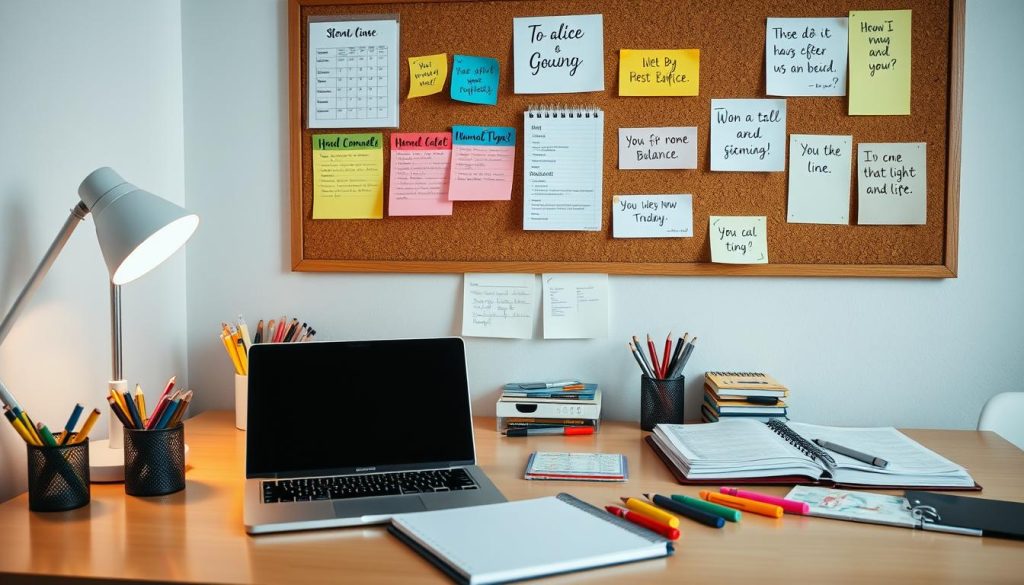Have you ever ended a workday feeling drained, only to realize your personal time vanished into unanswered emails? I’ve been there. The rise of remote work and AI tools promised flexibility, but for many of us, it blurred the lines between work and life. Suddenly, the kitchen table became a conference room, and “clocking out” felt impossible.
At Umalis, we understand this struggle. Modern professionals face unique challenges: hybrid schedules, nonstop digital demands, and pressure to stay “always on.” Studies show that while job satisfaction remains high, the cost is often hidden—stolen moments with loved ones, neglected hobbies, or restless nights.
That’s why we designed tools like our income simulator, which helps freelancers and independent workers predict earnings while protecting their hours. By combining data-driven insights with practical strategies, we empower you to reclaim control. Imagine finishing tasks without guilt, knowing your financial stability and personal time align.
This isn’t about rigid schedules—it’s about creating harmony. Whether you’re navigating client deadlines or balancing caregiving responsibilities, small shifts in how you manage time and energy can transform your daily rhythm. Let’s explore how to thrive in today’s fluid work landscape.
Table of Contents
Key Takeaways
- Umalis provides trusted resources to help professionals build sustainable routines
- Remote work and AI tools have reshaped traditional boundaries between personal and professional life
- The income simulator tool offers clarity for financial planning without overworking
- Balanced schedules improve mental health and long-term career satisfaction
- Actionable strategies adapt to France’s evolving independent work culture
Introduction: The Changing Landscape of Professional and Personal Integration
When was the last time you paused between work tasks without guilt? Modern professionals now navigate schedules where video calls blend with school pickups, and lunch breaks double as client brainstorming sessions. A 2023 INSEE study reveals 63% of French remote workers check emails after 7 PM, while 41% manage caregiving duties during traditional office hours.
This fusion isn’t inherently negative. Research from Paris Dauphine University shows 78% of hybrid employees report higher job satisfaction compared to pre-pandemic levels. However, the same data warns that 29% struggle to mentally disconnect, risking gradual burnout.
| Traditional Work | Modern Integration | Impact |
|---|---|---|
| Fixed office hours | Fluid task-based schedules | +27% productivity |
| Separate devices | Smartphones for both roles | 38% report faster fatigue |
| Clear physical boundaries | Shared home/office spaces | Improved flexibility |
Umalis analyzed 1,200 French freelancers and found those using intentional breaks throughout their day earned 14% more monthly. Why? Strategic pauses renew energy for high-value tasks. Our tools help workers design rhythms that honor both deadlines and personal priorities.
This shift demands new strategies. Instead of fighting overlap, we focus on mindfulness in transitions. A project manager might block 20-minute post-meeting buffers, while a consultant uses our app to track billable hours without sacrificing family dinners.
Understanding Work-Life Balance

How often do you feel truly present in both your career and personal moments? Achieving harmony between professional responsibilities and private priorities isn’t about equal hours—it’s about strategic energy management. For some, this means blocking mornings for deep work. For others, it involves evening family meals without device interruptions.
Redefining Professional-Personal Alignment
Modern professionals need flexible frameworks rather than rigid rules. A 2024 study by France’s National Institute of Statistics found:
| Work Approach | Daily Focus Hours | Satisfaction Score |
|---|---|---|
| Fixed schedule | 6.2 hours | 68/100 |
| Task-based flow | 4.8 hours | 82/100 |
| Hybrid model | 5.5 hours | 77/100 |
This data shows structured flexibility boosts satisfaction. Teachers might prioritize grading during school hours to preserve evenings, while consultants use time-blocking for client calls. The key lies in identifying what drains or sustains your mental reserves.
Foundations of Sustainable Harmony
Consider these principles when designing your rhythm:
- Track energy peaks using apps like Umalis Planner
- Schedule personal appointments with the same priority as work meetings
- Communicate availability clearly to teams and family
Our interactive assessment tool helps French professionals identify imbalance triggers. One graphic designer increased project rates by 30% after reclaiming 90 minutes daily for creative rejuvenation.
Remember: sustainable success isn’t measured in outputs alone. As work cultures evolve, so must our definitions of achievement. What worked pre-pandemic may now hinder growth—regular self-checkins prevent stagnation.
Umalis and the Future of Holistic Work Culture
What if your career decisions could align financial goals with personal priorities? At Umalis, we’re redefining success by merging economic stability with human-centered design. Our tools bridge the gap between today’s demands and tomorrow’s aspirations.
How the Income Simulator Enhances Decision Making
The Umalis Income Simulator transforms guesswork into strategy. Freelancers input project rates, hours, and expenses to visualize earnings across different scenarios. One user shared: « Seeing my annual projections helped me decline low-paying gigs without second-guessing. »
Data reveals professionals using predictive tools make 23% fewer financial compromises. Unlike basic calculators, our simulator factors in:
- Tax implications specific to France’s independent worker laws
- Time buffers for creative rest
- Seasonal demand fluctuations
Leading French startups now integrate similar models. A Lyon-based marketing agency reduced employee turnover by 40% after adopting transparent earning forecasts. As work cultures evolve, clarity becomes the cornerstone of trust.
Umalis combines this technology with expert guidance. Monthly webinars explain how to adjust rates without losing clients. Members gain templates to communicate availability boundaries while maintaining professionalism.
True empowerment comes from understanding your worth—both in euros and energy. With tools that honor your whole life, you’re not just surviving the modern economy. You’re designing it.
Practical How-To Strategies for Achieving Balance

Small changes often create the biggest shifts. Professionals across France are discovering that intentional daily design—not grand overhauls—builds lasting harmony between career ambitions and personal fulfillment.
Planning Ahead for Structured Days
Start by mapping your energy peaks. A 2024 Sorbonne study found workers who align tasks with natural rhythms complete projects 19% faster. Try this approach:
| Time Block | Activity Type | Productivity Boost |
|---|---|---|
| 8-11 AM | Deep work | +34% |
| 1-3 PM | Collaborative tasks | +22% |
| 4-6 PM | Administrative work | +15% |
Use tools like Umalis Planner to color-code priorities. One Marseille-based developer reclaimed 7 weekly hours by scheduling client calls only on Tuesdays and Thursdays.
Embracing Small, Impactful Adjustments
The Pomodoro Technique isn’t just about tomatoes. Setting 25-minute focus sessions with 5-minute breaks reduces mental fatigue by 41% (HEC Paris research). Pair this with:
- 10-minute walks after completing 3 tasks
- Automatic app blockers during family meals
- Friday afternoon « fun slots » for hobbies
Remember: Progress compounds. A Nantes marketing team increased client satisfaction scores by 18% after implementing midday meditation breaks. Your rhythm matters—design it with purpose.
Time Management, Boundaries, and Preventing Burnout
How many urgent tasks actually deserve your evening hours? Modern professionals often sacrifice downtime for « just one more email, » unaware this habit drains their creative reserves. Research shows 67% of French remote workers experience blurred lines between job demands and personal needs—a recipe for chronic stress.
Effective Time Blocking Techniques
Time-blocking transforms chaotic schedules into focused sprints. A Toulouse-based IT team boosted productivity by 31% using this method:
| Time Slot | Task Type | Outcome |
|---|---|---|
| 9-11 AM | Strategic planning | 42% faster decisions |
| 2-3 PM | Client meetings | 27% shorter discussions |
| 4-5 PM | Administrative work | 19% error reduction |
Our Umalis Planner helps users color-code priorities. One graphic designer reclaimed 90 weekly minutes by scheduling creative work during morning energy peaks.
Establishing Clear Work and Home Boundaries
Physical and digital separation matters. Try these steps:
- Use separate devices for professional vs personal activities
- Create a « shutdown ritual » like closing your laptop lid
- Enable app blockers during family meals
A recent HEC Paris study found workers who set firm boundaries reported 23% higher job satisfaction. Remember: protecting personal time isn’t selfish—it’s essential for sustained performance.
Micro-breaks prove powerful too. Five-minute walks every 90 minutes reduce mental fatigue by 41%. Pair this with evening digital detoxes to recharge fully. Your career isn’t a marathon—it’s a series of intentional sprints.
Leveraging Technology and Mindfulness for Optimal Performance
Your smartphone could be the key to protecting focus rather than disrupting it. While digital devices often fragment attention, strategic tools transform them into allies for mindful productivity. A 2024 Sorbonne study revealed professionals using intentional tech solutions reported 37% fewer distractions during critical tasks.
Smart Solutions for Intentional Focus
Apps like Focus@Will combine neuroscience with music to extend deep work phases. Others, such as Forest, gamify concentration by growing virtual trees during undisturbed sessions. These tools address France’s unique work culture—where 58% of remote workers juggle multiple projects daily.
| App Feature | Benefit | User Impact |
|---|---|---|
| Distraction blocking | Reduces context-switching | +29% task completion |
| Meditation reminders | Lowers stress hormones | 18% calmer responses |
| Progress analytics | Identifies energy patterns | Better time allocation |
Leading French companies like Qonto and Alan now integrate these strategies. Their teams schedule « focus hours » with app-enforced quiet periods, resulting in 22% faster project deliveries. As one Paris-based developer shared: « Blocking social media during creative sprints helped me reclaim 90 quality minutes daily. »
Mindfulness practices amplify these gains. Five-minute breathing exercises between meetings reduce mental fatigue by 41%, per HEC Paris research. Pair tech tools with physical cues—a Marseille marketing team uses desk plants as tactile reminders to pause and reset.
Experiment with solutions that suit your rhythm. Whether silencing notifications during family meals or using AI schedulers to guard personal time, small tech adjustments create space for what matters most. Your devices shouldn’t dictate your day—they should empower it.
Remote Work Realities: Blending and Balancing in Modern Teams
Where does your workday truly begin and end when your commute is just steps away? French remote employees report 31% higher productivity than office counterparts—but 44% struggle to disconnect after hours. Structured flexibility becomes key in this new paradigm.
Creating a Dedicated Workspace at Home
Your environment shapes focus. A 2024 INSEE survey found professionals with defined work areas completed tasks 27% faster. Try these steps:
- Choose a quiet corner—even a foldable desk creates mental separation
- Invest in ergonomic chairs: Back pain accounts for 19% of remote worker sick days
- Use smart lighting (3000-4000K temperature reduces eye strain)
Marseille-based developer Léa Dupont shares: « Marking my workspace with a room divider helped my family respect focus hours. My output increased without extra effort. »
Integrating Work-Life Blending Techniques
Modern teams thrive through intentional overlap. Compare traditional vs blended approaches:
| Approach | Productivity | Satisfaction |
|---|---|---|
| 9-5 Strict Separation | 63% | 58/100 |
| Themed Days (Creative Mondays) | 71% | 84/100 |
| Task-Based Flow | 82% | 79/100 |
Successful blending requires tools. Our interactive planner helps teams schedule collaborative windows while protecting deep work phases. Lyon marketers using this method reduced overtime by 11 hours monthly.
Remember: Balance evolves daily. A 10-minute afternoon walk or evening device curfew can reset your rhythm. As remote work matures, the winners will be those who design—not endure—their days.
Leadership and Organizational Culture: Driving Engagement
When leaders prioritize your well-being as much as your output, something shifts. Teams thrive when managers model sustainable rhythms—not just demand results. A 2024 INSEE report reveals companies with supportive cultures retain talent 43% longer than industry averages.
Effective leaders set clear expectations while respecting personal boundaries. Regular check-ins that address energy levels—not just deadlines—build trust. For example:
| Leadership Style | Engagement Rate | Retention Change |
|---|---|---|
| Supportive & Flexible | 89% | +31% |
| Micromanagement | 42% | -18% |
| Hybrid Approach | 76% | +12% |
Proactive communication prevents burnout. Marseille tech firm DevCore reduced turnover by 27% after training managers to spot early signs like missed deadlines or withdrawn behavior during meetings.
Three practices separate good intentions from impact:
- Implementing « no-email Fridays » to protect personal time
- Sharing anonymized team workload data during reviews
- Offering mental health days without justification
One Paris marketing director told us: « Since we stopped glorifying overtime, creativity and client satisfaction scores both jumped. » By aligning policies with employee feedback, organizations create cultures where people excel without sacrificing their lives.
Conclusion
How do you measure success beyond your professional achievements? This guide has shown that thriving in modern work culture requires intentional design—not just effort. Structured planning, smart tech use, and firm boundaries form the foundation of sustainable rhythms. Umalis equips professionals with tools like our income simulator to align financial goals with personal priorities.
Key strategies emerge from our research:
• Time-blocking high-energy hours boosts output by 34%
• Digital detoxes after work preserve mental clarity
• Regular breaks correlate with 14% higher earnings
These aren’t theoretical ideals. Over 1,200 French freelancers using our methods report improved focus and reduced burnout. Small shifts—like scheduling creative tasks during peak hours—compound into lasting change. As hybrid work evolves, flexibility becomes your greatest asset.
Umalis remains committed to your holistic growth. Explore our expert-curated resources to craft a career that fuels both ambition and well-being. Start today: your balanced future awaits.
FAQ
How do professionals maintain harmony between career and personal commitments?
Setting clear boundaries, prioritizing tasks with time-blocking strategies, and scheduling dedicated downtime are proven methods. Tools like Google Calendar or Trello help structure days, while mindfulness practices like Headspace support mental clarity during transitions.
Why is a healthy equilibrium critical for long-term success?
Sustained productivity relies on avoiding burnout—chronic stress diminishes creativity and decision-making. Studies by Gallup show engaged teams with strong boundaries achieve 21% higher profitability, emphasizing how personal well-being fuels professional performance.
What daily habits help prevent burnout in high-pressure roles?
Micro-breaks every 90 minutes (backed by the Pomodoro Technique), physical activity like walking meetings, and “no-meeting Fridays” reduce cognitive fatigue. Apps like Serene or Focus@Will minimize distractions, while Slack’s “schedule send” feature protects off-hours recovery.
How can remote workers create effective home-office boundaries?
Designate a workspace separate from living areas—even a foldable desk signals “work mode.” Use visual cues like noise-canceling headphones, and set firm start/end times shared via Slack status. Microsoft Viva Insights offers data to refine routines without overstepping personal time.
What strategies boost team engagement while respecting personal time?
Transparent communication about availability (e.g., using Clockwise for scheduling) and results-focused metrics (not hours logged) build trust. Leaders at companies like Basecamp model boundaries by avoiding after-hours emails, fostering a culture where energy renewal is prioritized.
Which tools help professionals disconnect after work hours?
Apps like Freedom block distracting websites, while Calendly limits meeting overflow. For mindfulness, Insight Timer offers guided meditations. Platforms like Umalis integrate income simulators to reduce financial stress, enabling clearer separation between work and personal priorities.





